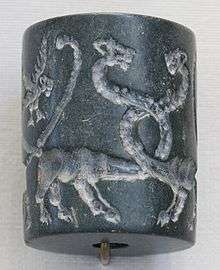Eblaite language
| Eblaite | |
|---|---|
| Region | Ebla |
| Era | 3rd millennium BCE[1] |
|
Afro-Asiatic
| |
| Language codes | |
| ISO 639-3 |
xeb |
Linguist list |
xeb |
| Glottolog |
ebla1238[2] |
Eblaite /ˈɛblə.aɪt/ (also known as Eblan ISO 639-3) is an extinct Semitic language which was used during the third millennium BCE by the East Semitic speaking populations of Northern Syria.[3] It was named after the ancient city of Ebla, in western modern Syria.[3] Variants of the language were also spoken in Mari and Nagar.[3][4] According to Cyrus H. Gordon,[5] although scribes might have spoken it sometimes, Eblaite was probably not spoken much, being rather a written lingua franca with East and West Semitic features.
Eblaite has been described as an East Semitic language which may be very close to pre-Sargonic Akkadian; its relation with the latter is debated :
- Scholars such as Richard I. Caplice, Ignace Gelb and John Huehnergard, have the view that Eblaite is not to be seen as an early Akkadian dialect,[6] because the differences with other Akkadian dialects are considerable.[7]
- Manfred Krebernik says that Eblaite "is so closely related to Akkadian that it may be classified as an early Akkadian dialect", although some of the names that appear in the tablets are Northwest Semitic.[8]
Eblaite is considered an East-Semitic language which exhibits both West-Semitic and East-Semitic features.[9][10] Grammatically, Eblaite is closer to Akkadian, but lexically and in some grammatical forms, Eblaite is closer to West-Semitic languages.[11]
The language is known from about 15,000 tablets[5] written with cuneiform script which have been found since the 1970s, mostly in the ruins of the city of Ebla.
References
- ↑ Eblaite at MultiTree on the Linguist List
- ↑ Hammarström, Harald; Forkel, Robert; Haspelmath, Martin; Bank, Sebastian, eds. (2016). "Eblan". Glottolog 2.7. Jena: Max Planck Institute for the Science of Human History.
- 1 2 3 Keith Brown, Sarah Ogilvie (2010). Concise Encyclopedia of Languages of the World. p. 313.
- ↑ Edward Lipiński (2001). Semitic Languages: Outline of a Comparative Grammar. p. 52.
- 1 2 Gordon, "Amorite and Eblaite", page 101
- ↑ Robert Hetzron (2013). The Semitic Languages. p. 7.
- ↑ Jerrold S. Cooper, Glenn M. Schwartz (1996). The Study of the Ancient Near East in the Twenty-first Century: The William Foxwell Albright Centennial Conference. p. 259.
- ↑ Krebernik, "Linguistic Classification"
- ↑ Alan S. Kaye (1991). Semitic studies, Volume 1. p. 550.
- ↑ Robert Hetzron (2013). The Semitic Languages. p. 101.
- ↑ Watson E. Mills,Roger Aubrey Bullard (1990). Mercer Dictionary of the Bible. p. 226.
Bibliography
- A. Archi. 1987. "Ebla and Eblaite," Eblaitica 1. Ed. C.H. Gordon. Winona Lake, Indiana: Eisenbrauns. Pages 7–17.
- Cyrus H. Gordon. 1997. "Amorite and Eblaite," The Semitic Languages. Ed. Robert Hetzron. New York: Routledge. Pages 100-113.
- Manfred Krebernik. 1996. "The Linguistic Classification of Eblaite: Methods, Problems, and Results." In The Study of the Ancient Near East in the Twenty-First Century: The William Foxwell Albright Centennial Conference (eds. J.S. Cooper – G.M. Schwartz), pp. 233–249.
- G. Rubio 2006. "Eblaite, Akkadian, and East Semitic." In The Akkadian Language in its Semitic Context (ed. N.J.C. Kouwenberg and G. Deutscher. Leiden: Nederlands Instituut voor het Nabije Oosten), pp. 110–139.
